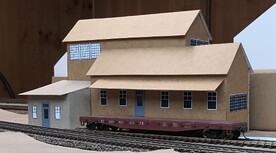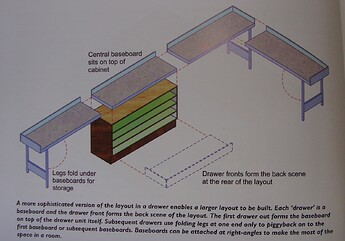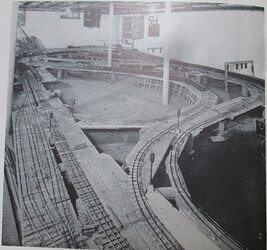I will be discussing what I would consider my ideal dream HO scale layout, in the future on a budget. I’m currently living in an apartment, I don’t have lot’s of space available. I have no idea how much space (or budget) I might have available in the future, so I’m keeping my plans realistic and achievable. Because of my living situation, I believe aiming at a point to point switching layout on shelving, would be a practical dream to have. To keep it on a budget, I would be avoiding sound and DCC, instead doing plain old DC power. My plan is to model somewhere between 1940 and 1960 approximately. I would be keeping to small steam locomotives (such as 0-6-0, 4-6-0, 2-8-0), and 4 axle (8 wheel) diesel locomotives, and freight cars between generally 40 and 50 feet long. That kind of equipment is more compatible with small layouts.
I might decide to model something like the short line Ma & Pa (Maryland and Pennsylvania) Railroad. At its peak, the railroad had sixteen locomotives, and 160 pieces of rolling stock. Or I might do proto-freelancing, operating an imaginary freelanced railroad, as if it’s a real full size prototype railroad. I might purchase the majority of my locomotives undecorated, and paint and decal them myself. I already have a few painted Athearn Blue Box diesel locomotives, but I might get some undecorated shells and decorate them myself, in my own freelanced scheme.
For various reasons I intend to keep to using mostly Athearn Blue Box diesel locomotives for my fleet. Perhaps a few locomotives from other companies (like vintage Atlas, Stewart Hobbies, Kato, Hobbytown of Boston, etc). But at first the majority will be Athearn Blue Box diesels bought undecorated to paint and decal myself. I will super detail the Athearn locomotives, so they look a little more realistic. I prefer the Blue Box locomotives with the metal hand rails, I don’t like fragile plastic hand rails. Currently I have a handful of locomotives.
Currently I have about 25 freight cars, the majority are Athearn BB and MDC Roundhouse kits. Eventually I will get more freight cars from various manufacturers, such as Athearn Yellow and Blue Box kits, Model Die Casting Roundhouse kits, Globe Models, Accurail kits, Atlas, Kato, Kadee, Branch Line Trains, Bowser, Con-Cor, IHC, AHM, Rivarossi, Life-Like, Life-Like Proto 2000, Life-Like Proto 1000, Bachmann, Bachmann Plus, Bachmann Silver Series, Model Power, Tyco, Mantua, Silver Streak, Ulrich, Quality Craft, Gloor Craft Models, Varney, Revell, Penn-Line, Red Ball, Menzies, Ambroid, Labelle, Ye Old Huff’ n Puff, Train Miniature, Walthers, Marx HO, Lionel HO, Gilbert American Flyer HO, Roco, Lima, Fleischmann (American versions), etc.
I will upgrade most of the locomotives to have body mounted Kadee couplers. And most freight cars to have metal wheels and body mounted Kadee couplers. A few can keep the original horn hook couplers. I will paint and decal some of the locomotives and freight cars. And make most of them look dirty and weathered, and modify and add details as needed, etc.
With the nicer freight cars (such as Athearn, Roundhouse, Accurail, Atlas, etc), I will be adding metal wheelsets and Kadee couplers as needed. With the train set quality freight cars (Tyco, Model Power, AHM, etc) I will be adding separate roof walks, brake wheels, ladders, individual grab irons and steps, etc. And adding metal wheelsets and body mounted Kadee couplers. And I will paint and decal many of them. Unless I want to keep them original. And add weight so everything is according to NMRA weight standards, or at least close enough to it. That way the least expensive plastic models can look and perform as good as the more expensive models.
I plan on using code 100 flextrack, both nickle silver and brass rails because it’s already on hand. I might scratch build some of my own switches (turnouts), or I might use Atlas Custom Line, Peco, Shinohara, Micro-Engineering, Walthers, etc turnouts. I could also use code 83 track and turnouts. I would prefer to use switches that are all metal through the frogs, no plastic frogs. I have a decent amount (around 30 to 35) of the vintage Tru-Scale turnout kits, with the “high speed” closed frog design. I just don’t know if I want to use all of that vintage code 100 brass track, and replace it with nickle silver track. I could handlay my own track and turnouts, with code 70 and 83 rails, soldered to PCB (printed circuit board ties), and individual wood ties glued down to the roadbed. It would look better compared to the old code 100 track I have, and be very economical to scratch build my own turnouts.
I will be using regular DC power packs from MRC (Model Rectifier Corporation), I don’t need DCC. I already have a couple Tech 2 MRC power packs anyway.
I plan on building my own structures and buildings from scratch, from simple kits, and kit bashing, and modifying structures. And I will also purchase some used kits, and modify and repaint them to look better. Purchase non-painted figures (people) and paint them myself. Build my own trees from scratch.
I will be modeling a short line freelanced imaginary railroad, or something like the Ma and Pa (Maryland and Pennsylvania). In either case set in rural mountain type scenery, with lot’s of bridges and some tunnels. And some small towns and industry for switching. I will purposely buy equipment that is known to handle 18 to 22 inch radius curves, because I might never have lot’s of space to build a large layout with wide sweeping curves. Which means short steam locomotives and 4 axle diesel locomotives, and freight cars no longer then about 50 feet. I don’t want to buy longer equipment and never be able to use it on a layout. I currently live in an apartment, so I will be planning on what makes sense for a small layout.
If I happen to move to a larger place in the future, like a home with a basement, then sure I would get some longer locomotives and rolling stock. But otherwise I will keep to shorter equipment, which can handle 18 to 22 inch radius curves.



